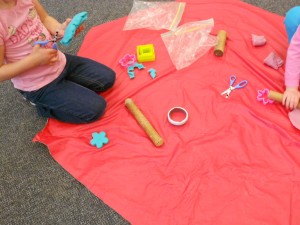What kindergarten readiness learning and fun can be squished, rolled, cut, stretched, smooshed, and patted? Playdough, of course. (Plus it starts with a p since April starts with a p.) Playdough can be played with in other ways, too. It’s a great toy for children at several stages. Once kids have learned that playdough doesn’t go in their mouth, it can be used for simple exploration and sensory stimulation. Older ones can imagine and create with playdough. Children may also roll out letters and numbers, make shapes, map out roads for making tracks from toys with wheels, and practice using scissors.
 As kids play with playdough they are also improving fine motor dexterity. The small muscles in the hands, fingers, and wrists are still developing. The brain also gets lots of exercise for problem-solving and planning and other thinking skills. Two colors of playdough added another element to the fun for these kids. Instead of using a table, the big plastic sheet spread on the floor gave much more space–and kept the playdough off the carpet.
As kids play with playdough they are also improving fine motor dexterity. The small muscles in the hands, fingers, and wrists are still developing. The brain also gets lots of exercise for problem-solving and planning and other thinking skills. Two colors of playdough added another element to the fun for these kids. Instead of using a table, the big plastic sheet spread on the floor gave much more space–and kept the playdough off the carpet.
Instead of the usual toys, add some kitchen utensils and other items. A rolling pin, wooden spoon, potato masher, plastic fork, and egg turner are possibilities. Bottle lids of various sizes make small circle tracks. Kids can hide small items in the dough and then find them again. Playdough can be made very inexpensively at home; there are tons of recipes and ideas. Try a few different ones until you find the one that works best. This video below explains it well and the dough does look exactly like the sticky paste and then a big lump. Add a drop or two of essential oil for a lovely smell. These two children are different ages and do not play with the playdough the same way. How does your child like to play with playdough?
